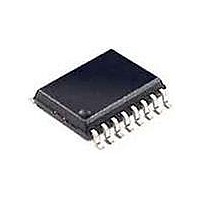FAN9611MX Fairchild Semiconductor, FAN9611MX Datasheet - Page 11

FAN9611MX
Manufacturer Part Number
FAN9611MX
Description
Power Factor Correction ICs Interleaved Dual BCM PFC Controller
Manufacturer
Fairchild Semiconductor
Datasheet
1.FAN9611MX.pdf
(37 pages)
Specifications of FAN9611MX
Switching Frequency
525 KHz
Maximum Operating Temperature
+ 125 C
Mounting Style
SMD/SMT
Package / Case
SOIC-16
Minimum Operating Temperature
- 40 C
Lead Free Status / Rohs Status
Details
Available stocks
Company
Part Number
Manufacturer
Quantity
Price
Part Number:
FAN9611MX
Manufacturer:
FAIRCHILD/仙童
Quantity:
20 000
© 2008 Fairchild Semiconductor Corporation
FAN9611 / FAN9612 • Rev. 1.1.3
8. Power Limit
The architecture and operating principle of FAN9611/12
also provides inherent input power limiting capability.
When the slope of the PWM ramp is made proportional
to the square of the input RMS voltage, the maximum
on-time of the boost power switch becomes inversely
proportional to the square of V
Figure 14. In boundary-conduction mode, the peak
current of the boost transistor is proportional to its on
time. Therefore, controlling the maximum pulse width of
the gate drive signal according to the curve shown is an
effective
independent power limit for the boost PFC.
9. Light-Load Operation (Phase Management)
One of the parameters determining the operating
frequency of a boundary conduction mode converter is
the output power. As the load decreases, lower peak
currents are commanded by the pulse width modulator
to maintain the output voltage at the desired set point.
Lower peak current means shorter on-time for the power
transistor and shorter time interval to ramp the inductor
current back to zero at any given input voltage. As a
result, the operating frequency of the converter
increases under light load condition.
As the operating frequency and corresponding switching
losses increase, conduction losses diminish at the same
time. Therefore, the power losses of the converter are
dominated by switching losses at light load. This
phenomenon is especially evident in a BCM converter.
To improve light-load efficiency, FAN9611/12 disables
one
automatically when the output power falls below
approximately 13% of the maximum power limit level.
By managing the number of phases used at light load,
the FAN9611/12 can maintain high efficiency for a wider
load range of the power supply.
Normal
converters resumes automatically once the output
power exceeds approximately 18% of the maximum
power limit level of the converter.
By adjusting maximum on-time (using R
management thresholds can be adjusted upward,
described in the “Adjusting the Phase-Management
Thresholds” section of this datasheet.
of
interleaved
method
the
Figure 14. On-Time vs. V
two
to
operation
interleaved
implement
IN,RMS
of
, as represented in
boost
an
IN_RMS
the
MOT
input-voltage
), the phase
two
converters
boost
11
10. Brownout Protection with Soft Recovery
An additional protection function usually offered by PFC
ICs is input brownout protection to prevent the converter
from operating below a user-defined minimum input
voltage level. For this function to work, the input voltage
of the converter is monitored. When the voltage falls
below the brownout protection threshold, the converter
stops working. The output voltage of the boost converter
falls until the load stops drawing current from the output
capacitor or until the input voltage gets back to its
nominal range and operation resumes.
As the output falls, the voltage at the feedback pin falls
proportionally, according to the feedback divider ratio.
To facilitate soft recovery after a brownout condition, the
soft-start capacitor – which is also the reference voltage
of the error amplifier – is pulled lower by the feedback
network. This effectively pre-conditions the error
amplifier to provide closed-loop, soft-start-like behavior
during the converter’s recovery from a brownout
situation. Once the input voltage goes above the
brownout protection threshold, the converter resumes
normal operation. The output voltage rises back to the
nominal regulation level following the slowly rising
voltage across the soft-start capacitor.
11. Soft Starting the Converter
During startup, the boost converter peak charges its
output capacitor to the peak value of the input voltage
waveform. The final voltage level, where the output is
regulated during normal operation, is reached after the
converter starts switching. There are two fundamentally
different approaches used in PWM controllers to control
the startup characteristics of a switched-mode power
supply. Both methods use some kind of soft-start
mechanism to reduce the potential overshoot of the
converter’s output after the desired output voltage level
is reached.
The first method is called open-loop soft-start and relies
on gradually increasing the current or power limit of the
converter during startup. In this case, the voltage error
amplifier is typically saturated, commanding maximum
current until the output voltage reaches its final value. At
that time, the voltage between the error amplifier inputs
changes polarity and the amplifier slowly comes out of
saturation. While the error amplifier recovers and before
it starts controlling the output voltage, the converter
operates with full power. Thus, output voltage overshoot
is unavoidable in converters utilizing the open-loop soft-
start scheme.
Figure 15. Automatic Phase-Control Operation
www.fairchildsemi.com












